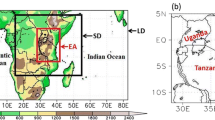Abstract
Iran anticyclone is one of the main features of the summer circulation over the Middle East in the middle and upper troposphere. To examine the effect of the Zagros Mountains on the formation and maintenance of the Iran anticyclone, an experiment was conducted by Regional Climate Model (RegCM4) in an area between 22°–44°N and 35°–70°E with a 40 km horizontal grid spacing. The NCEP/NCAR re-analysis data set were used to provide the initial and lateral boundary conditions in a control run and in a simulation run by removing the Zagros Mountains. The result reveals that the Zagros Mountains have an important effect on the formation and maintenance of the low-level cyclonic circulation and mid-level anticyclonic circulation in summer. Examining the diabatic heating shows that the elimination of the Zagros Mountains causes a significant change in the heating values and its spatial distributions over the study area. Comparing the diabatic heating terms, the vertical advection term has the main contribution to the total heating. In the absence of the Zagros Mountains, the vertical advection and the mid-troposphere anticyclonic circulation are apparently weak and, therefore, the Iran subtropical anticyclone vanishes over the west of Iran. The study indicates that the Zagros Mountains as an elevated heat source have the main impact in the formation of a thermally driven circulation over the Middle East.









Similar content being viewed by others
References
Chen P, Hoerling MP, Dole RM (2001) The origin of the subtropical anticyclones. J Atmos Sci 58:1827–1835
Duan AM, Wu GX (2005) Role of the Tibetan Plateau thermal forcing in the summer climate patterns over subtropical Asia. Clim Dyn 24:793–807
Giorgi F, Marinucci MR, Bates GT (1993a) Development of a second generation regional climate model (REGCM2). Part I. Boundary layer and radiative transfer processes. Mon Weather Rev 121:2794–2813
Giorgi F, Marinucci MR, Bates GT, DeCanio G (1993b) Development of a second generation regional climate model (REGCM2). Part II. Convective processes and assimilation of lateral boundary conditions. Mon Weather Rev 121:2814–2832
Hahn DG, Manabe S (1975) The role of mountains in the south Asian monsoon circulation. J Atmos Sci 32:1515–1541
Hoskins BJ (1991) Towards a PV-view of the general circulation. Tellus 43AB:27–35
Hoskins BJ (1996) On the existence and strength of the summer subtropical anticyclones. Bernhard Haurwitz memorial lecture. Bull Am Meteorol Soc 77:1287–1292
Kalnay E, Kanamitsu M, Kistler R, Collins W, Deaven D, Gandin L, Iredell M, Saha S, White G, Woollen J, Zhu Y, Leetmaa A, Reynolds B, Chelliah M, Ebisuzaki W, Higgins W, Janowiak J, Mo KC, Ropelewski C, Wang J, Jenne R, Joseph D (1996) The NCEP/NCAR 40-year reanalysis project. Bull Am Meteorol Soc 77:437–472
Liu Y, Wu GX (2004) Progress in the study on the formation of the summertime subtropical anticyclone. Adv Atmos Sci 21(3):322–342
Liu XD, Yin ZY (2002) Sensitivity of East Asian monsoon climate to the Tibetan Plateau uplift. Palaeogeogr Palaeoclim Palaeoecol 183:223–245
Liu Y, Wu GX, Ren R (2004) Relationship between the subtropical anticyclone and diabatic heating. J Clim 17:682–698
Pal JS, Giorgi F, Bi X, Elguindi N, Solmon F, Gao X, Rauscher SA, Francisco R, Zakey A, Winter J, Ashfaq M, Syed FS, Bell JL, Diffenbaugh NS, Karmacharya J, Konare J, Martinez D, da Rocha RP, Sloan LC, Steiner A (2007) Regional climate modeling for the developing world: the ICTP RegCM3 and RegCNET. Bull Am Meteorol Soc 88(9):1395–1409
Peixoto JP, Oort AH (1992) Physics of Climate. Springer, Berlin, pp 46–51
Qian Y, Zhang Q, Yao Y, Zhang X (2002) Seasonal variation and heat preference of the South Asia High. Adv Atmos Sci 19:821–836
Rodwell MJ, Hoskins BJ (1996) Monsoons and the dynamics of deserts. Q J R Meteorol Soc 122:1385–1404
Rodwell MJ, Hoskins BJ (2001) Subtropical anticyclones and summer monsoons. J Clim 14:3192–3211
Schulman LL (1973) On the summer hemisphere Hadley cell. Q J R Meteorol Soc 99:197–201
Wu GX, Liu Y, Liu P (2004) Formation of the summertime subtropical anticyclone. In: Chang CP (ed) East Asian Monsoon. World Scientific Publishing Company, Singapore
Wu G, Liu Y, Wang T, Wan R, Liu X, Li W, Wang Z, Zhang Q, Duan A, Liang X (2007) The influence of mechanical and thermal forcing by the Tibetan plateau on Asian climate. J Hydrometeorol 8:770–789
Yeh TC (1982) Some aspects of the thermal influences of the Qinghai–Tibetan Plateau on the atmospheric circulation. Arch Meteorol Geophys Bioclimatol Ser A31:205–220
Zaitchik BF, Evans JP, Smith RB (2007) Regional impact of an elevated heat source: the Zagros Plateau of Iran. J Clim 20:4133–4146
Zarrin A (2008) The analysis of summertime subtropical anticyclone over Iran, PhD thesis. Tarbiat Modares University, Tehran (in Persian)
Zarrin A, Ghaemi H, Azadi M, Farajzadeh M (2010) The spatial pattern of summertime subtropical anticyclones over Asia and Africa: a climatological review. Int J Climatol 30:159–173
Zhang Q, Wu GX, Qian Y (2002) The bimodality of 100 hpa South Asia High and its relationship to the climate anomaly over East Asia in summer. J Meteorol Soc Jpn 80:733–744
Author information
Authors and Affiliations
Corresponding author
Additional information
Responsible editor: B. Ahrens.
Rights and permissions
About this article
Cite this article
Zarrin, A., Ghaemi, H., Azadi, M. et al. The effect of the Zagros Mountains on the formation and maintenance of the Iran Anticyclone using RegCM4. Meteorol Atmos Phys 112, 91–100 (2011). https://doi.org/10.1007/s00703-011-0134-z
Received:
Accepted:
Published:
Issue Date:
DOI: https://doi.org/10.1007/s00703-011-0134-z




